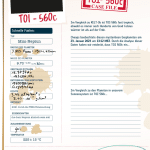
Project Gallery 2023
Secondary students from across Europe became exoplanet detectives with ESA and used Cheops satellite data to uncover the mysteries of two exoplanet targets: KELT-3b and TOI-560c.
Explore the projects below.
Team-A
Best Project Prize Winner
Meranier-Gymnasium Lichtenfels – Bavaria Germany 16 years old 1 / 1
KELT-3b
KELT-3b project description:
Kelt-3b has some similarities to planets in our solar system as well as differences. Those will be explained in the following. With its radius of 17.5 times the radius of earth it’s even bigger than the biggest of our planets Jupiter with 11.21 times the radius of earth. Even though its bigger than any of our planets it’s pretty close to its star with about 7111594 km or 0.0475 au. That distance is even smaller than the distance of Mercury which is the closest plane to our sun. The consequence of that small distance is a high temperature, with 1534°C it is a lot hotter than any of our planets. In fact, it is more than four times the temperature of Venus (our hottest planet). If you determine the planets density, you discover that this is an aspect which is pretty similar to one of our planets: It has a density of about 0.63 g/cm3, that is pretty close to Saturn’s density of 0.69 g/cm3. This means that Kelt-3b has to be similar in its composition too, which means it consists out of gas. Considering its close proximity to its star as well as its composition it’s noticeable that Kelt-3b could not be a planet, where life is possible because looking at its temperature, which we believe to be the source of life, could not be a fluid there.
TOI-560c
TOI-560c project description:
Our calculation and data analyzation for the exoplanet TOI-560c were made to determine the exoplanet’s characteristics like the Radius, Mass or its location in relation to its star. Those results were used to compare TOI-560c to planets of our solar system. The data used originates out of data collected by the space telescope CHEOPS. One method used for determining for example the radius of the planet was the analyzation of a graph made with the transit method. The main result of our investigation was the planets similarity in size to the planet Neptun in our solar system as well as the planets really low density, which is even lower than Saturn’s. Additionally, the planet is relatively close to its star, in comparison being even closer than Mercury to our sun.
TOI-560c Results and Analysis
For the complete analysis and results of TOI-560c please see attached file below.
TOI-560c Conclusions
With the calculations’ results and our analyzing of the data we came to following conclusions: The exoplanet’s radius of 3.0059 times the radius of the Earth is only a bit smaller than Neptun’s radius of 3.88 times the radius of the Earth. This means that the exoplanet is relatively big compared to half of the planets of our solar system, Neptun being one of the bigger planets. The planet’s orbital period – determined through the transit method – in in comparison to the planets of our solar system is really low, with it being about 19 days, which less than a fifth of the lowest orbital period in our solar system, which is about 88 days (Mercury). This also has to mean that it is way closer to its star than our planets to the sun: its orbital distance is about 0.125 au with again is way lower than Mercuries (0,39 au). From this follows that the temperature of the planet has to be a lot higher than Mercuries (167) too in our data it was estimated to be about 225 °C. But the temperature is lower than Venus’ 464°C. This means that the planet could not be habitable – at least in our understanding of possibility and necessities for life -, because possible water would not be fluid there but a gas. Furthermore, the temperature would also be way to high for life to survive there. TOI-560c’s composition is also pretty different to the planets in our solar system: its density is about 3.49 times 105 kg/km3 or 3,49 times 10-7 g/cm3, which is a lot lower than the lowest density in our solar system (Saturn: 0.69 g/cm3 ) which means the exoplanet has to be a gas planet even less dense than Saturn.
Summarizing: TOI-560c has a lot of differences in characteristics compared to the planets in our solar system. Although it’s at least similar in some aspects such as the size, it is mostly different. The planet isn’t probable to be habitable, because of its low density, which means it’s a gas planet, as well as the high temperature, which means that there could be no fluid water. This is also recognizable by the distance to its star with is a lot smaller than a planet that would be in the habitable zone of a star.
Supporting files:



